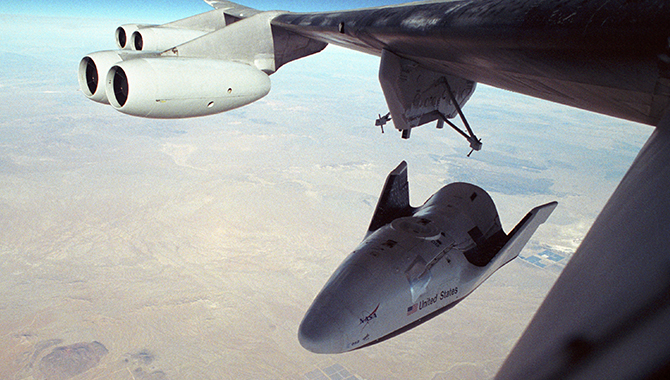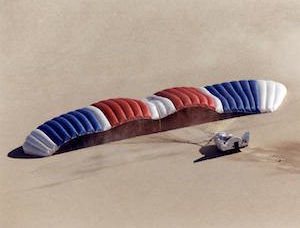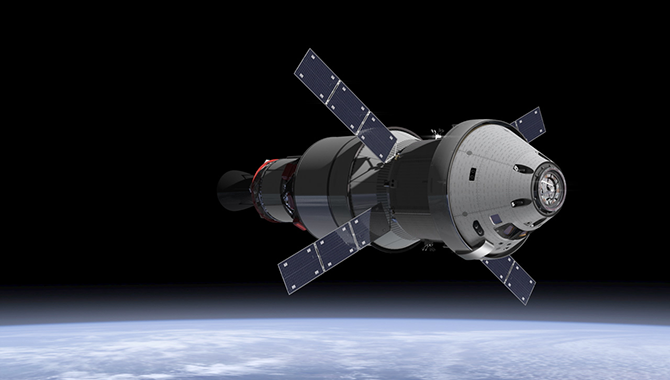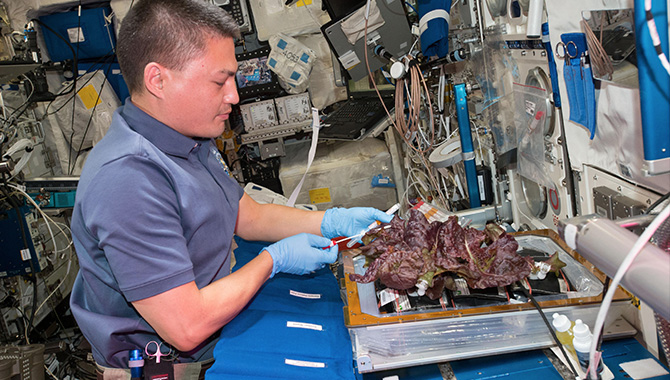
On December 13, 2001, the V-131R dropped away from the wing of the B-52 “mothership” for what turned out to be the longest and fastest flight of the X-38 program.
Photo Credit: NASA/Carla Thomas
On March 12, 1998, the X-38—a novel prototype for a proposed International Space Station (ISS) Crew Return Vehicle (CRV)—flew for the first time.
The X-38 emerged out of a synergy between the international space community’s need for safety and desire for science. In 1992, NASA’s Aerospace Safety Advisory Panel stated that a dedicated vehicle was needed to safely and quickly ferry all space station crew back to Earth in the event of an emergency. When Russia signed on as a partner to the burgeoning station in 1993, they agreed to provide a Soyuz that would remain docked at the station, ready to return crew as needed. The problem was capacity: the Soyuz could transport only three crew at a time, which limited the number of astronauts that could be on the ISS conducting research.
To increase crew capacity and expand scientific research capabilities, NASA proposed the development of a CRV that could hold multiple astronauts. The vehicle had several specifications. First, it had to be large enough to transport as many as seven crew at once. Second, it had to be capable of a precision landing on the ground, not on water, to enable swift recovery of any ill or injured astronauts. Third, it had to be cost effective.
Initial calculations pointed to a cost of $2 billion for a CRV, which was far more expensive than desired. But the X-38 team, assembled under program manager John Muratore, figured out a way of containing costs by utilizing existing, proven technology coupled with off-the-shelf components. They proposed a spacecraft design based on the X-24A: the second-to-last aircraft in the joint NASA-Air Force lifting body program, which ran at Dryden Flight Research Center from 1963 to 1975. The X-24A’s wingless design had already been proven to provide excellent lift and speed, which would be necessary for the CRV to glide, unpowered, from space and reach a targeted destination on Earth. A scaled-down version with movable fins and body flaps could fit into the space shuttle to be carried to the ISS, where it would remain docked until needed. In the future, a modified version of the CRV might be used in a NASA-ESA (European Space Agency) project to be launched on the French Ariane rocket.

The first flight of the V-131R, which took place on November 2, 2000, featured a full-scale parafoil for the first time.
Photo Credit: NASA/Carla Thomas
The main problem with the X-24A design was landing. At the slow speeds required for precision touchdowns, the lifting body design lost stability, endangering any crew on board. To counter this problem, the team proposed using an enormous, steerable parafoil, deployed after reentry, to guide and slow the X-38 toward a safe landing. Like the spacecraft, the parafoil would utilize existing technology by following a U.S. Army design.
Other elements of the X-38 design were based on proven technology as well. The flight control and flight software operating systems had previously been used for commercial operations. The navigation system was programmed to a GPS that was already incorporated into Navy planes. The actuators, which controlled pitch, yaw, and roll, were preexisting.
Even so, the X-38 represented a number of “firsts” for spaceflight. Its controls were entirely electric: a battery pack provided all power required to operate the spacecraft systems, from avionics, navigation, and guidance to the flight control and parachute-steering systems. It relied on GPS for navigation, which had never before been done for human spaceflight. Finally, its steerable parafoil was the largest in the world. At nearly one and a half times the wingspan of a 747 jet, the 7,500-square-foot chute required a custom-designed staging system to fully deploy without ripping in high winds.
The proposed mission profile was simple. In the event of an emergency, the ISS crew would enter the CRV and undock, a process expected to take less than 30 seconds. Once detached, a small, disposable propulsion unit, mounted at the back of the X-38, would fire to slow the spacecraft’s speed in order to deorbit. The rocket—the only non-reusable component on the CRV— would then be jettisoned. The CRV would enter Earth’s atmosphere at an altitude of roughly 80 miles, going 18,000 miles per hour. At 23,000 feet, a drogue parachute would deploy, followed by the main parafoil, which steered the vehicle automatically to the landing site. The CRV would land, on skids, going less than 40 miles per hour. The entire event, which was expected to take two to three hours, was automated. The onboard computer was given landing coordinates by Mission Control, which informed the navigation and flight control systems and, eventually, the parafoil. A manual backup system was available, if needed.
To get the program aloft, two initial, sub-scale prototypes were commissioned in 1996 from Scalable Composites. Designed at 80% of the final proposed CRV size, the vehicles were 28.5 feet long, 14.5 feet wide, and weighed an average of 16,000 pounds. The first, V-131, arrived at Johnson Space Center (JSC) in September 1996. The second, V-132, arrived three months later. After being outfitted with the requisite systems, the vehicles were transported to Dryden for atmospheric flight tests.
The initial V-131 flights, which took place in the summer of 1997, were “captive-carry” tests. The vehicle remained attached to the wing of a B-52 bomber—the same “mothership” used in the X-15 and lifting body programs—generating data that allowed the team to assess its aerodynamics. The first free flight, in which the vehicle was dropped from the B-52 at 23,000 feet, took place on March 12, 1998. Problems with the sub-scale, 5,000-square-foot parafoil delayed the next flight until February 1999. Data from these flights were used to assess launch characteristics, parachute operation, and landing.
The V-132, which contained more sophisticated systems than its predecessor, took its first flights in March and July 1999. In March 2000, the V-132 was dropped from 39,000 feet, a height that enabled it to adopt the trajectory of a vehicle returning from space.
A final prototype, V-131R, was a modified version of the V-131. Unlike the previous vehicles, the V-131R utilized a full-size, 7,500-square-foot parafoil. Captive flight tests began in August 2000, with the first free flight occurring in November 2000. A seventh X-38 flight took place on July 10, 2001, followed by the longest, fastest, highest flight of the V-131R in December of the same year.
The V-201—a version of the X-38 to be tested in space—was 90% complete when the program was canceled. Cancelation had nothing to do with program results: all involved were pleased with the progress of the spacecraft and parafoil development and the test flights. But in the spring of 2002, the X-38 CRV program became a casualty of cost-cutting measures taken to contain the U.S. investment in the ISS. On station, two Soyuz capsules remain at the ready, prepared to provide swift evacuation of crew, if needed.
Read an APPEL News article about the Flying Bathub—the first vehicle in the joint NASA-Air Force lifting body program.
Read an APPEL News article about the X-24B, the final vehicle in the lifting body program.









